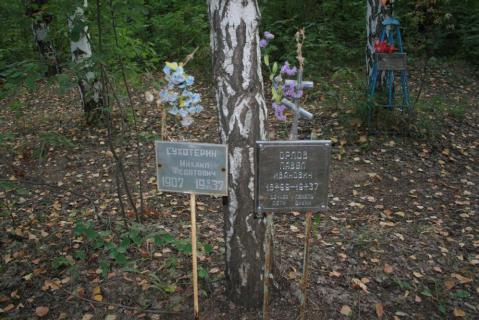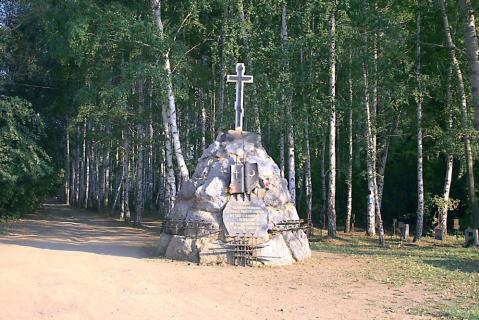From the late 1920s onward part of the floodplain of the Ural river in the south part of the city was used for burying the inhabitants of Orenburg and the Orenburg Region who were shot or died in the city’s prisons. Later an NKVD-MGB “special site” (recreation area) was located there. It occupied about two hectares and was surrounded by a high fence. According to the Orenburg Region FSB more than 8,400 people executed in the city were buried in the 1930s-1950s, in both pits and rows.
During seasonal floods in the 1940s-1950s the banks of the Ural river were periodically washed away, exposing human remains. The city executive committee decided to shift the course of the river one kilometre away; the erosion was made good, and the banks were strengthened. At the end of the 1950s a birch wood was planted there. Subsequently the land was given to the railway workers union as a recreation area. In the mid-1970s it passed under the control of the regional KGB.
Responding in 1988 to a formal enquiry from the Orenburg Memorial Society the Orenburg Region KGB indicated that the land was one place where the victims of political repression were buried and the next year it was transferred to the city. The fence was taken down and the guards quarters and maintenance buildings of the 1930s were demolished. The area of the burials has been fully preserved within its historic boundary. The trenches and pits have not been contoured. Investigation and exhumation have not been conducted because available archival documents confirm the burials. Only in September 2007 was a forensic examination carried out when the river bank 1 kilometre from the memorial was eroded and the remains of five people with bullet holes in their skulls were discovered. Report No. 459 (October 2007) established that the remains had lain in the ground no less than 40 years.
In May 1989, thanks to the efforts of G.P. Donkovtsev, chairman of the Orenburg city soviet, a small memorial “To the victims of Stalinist repression” was put in place. Resolution No 144 (26 September 1993) of the Orenburg city soviet recognised the Zauralskaya roshcha (wood) as a “Monument in memory of the victims of political repression” and confirmed an annual Day in Commemoration of the Victims of Political Repression. That year the city’s landscaping trust begin work to create the memorial area. Asphalt was laid and an Avenue of Remembrance was defined. On 11 June 1993, thanks to the Orenburg Memorial society and the Orenburg Region Administration a memorial was established and unveiled. It is in the form of a pyramid of granite boulders (architect P.G. Kantsev, sculptor A.B. Yemayev) with a cross, a Star of David and a crescent moon to represent the Christian, Jewish and Muslim faiths. The inscription reads: “may you, great martyrs unjustly shot during the years of Stalinist repression, be remembered forever”.
In January 2014 the city’s town-planning council adopted a draft proposal for reconstruction of the memorial.
As of the present more than one hundred personal memorials (grave markers, plaques with names attached to trees) have been placed in the grounds of the memorial. They all have a symbolic character since the exact location of a person’s burial is unknown. After a fire in 2010 when the wood was severely burnt these personal memorials also suffered. Since then, they have been restored.
Solemn commemorative ceremonies (meetings and funeral services) take place on several days each year. The memorial is distinguished on the city map with the symbol that indicates “historical and commemorative sites”. Lists of those shot have been published in the two volumes of the Orenburg Region’s Book of Remembrance.
A Book in Remembrance of the Victims of Political Repression in the Orenburg Region (3 vols. 1998-2015) includes about 18,000 biographical entries on those shot or sent to the camps.
Memorial’s database (2025) names 38,135 victims in the Orenburg Region (BR 18,830).
6,863 were shot, 5,760 of them condemned to death in 1937-1938. Cases against 25 other individuals were closed: 18 of them died in custody. Аlmost 10,000 were sent to the camps and a thousand deported. Police records list more families and individuals (total 19,304) who were deported: 4,186 during collectivisation, and 4,480 for their “nationality” in the 1940s and 1950s.
| Date | Nature of ceremonies | Organiser or responsible person | Participants | Frequency |
|---|---|---|---|---|
|
July (second Saturday)
|
Orenburg's own Day in Memory of the Victims of Political Repression
|
Orenburg Region administration
|
Regional and city officials, NGOs, relatives of the victims, clergy
|
Annual event since 1993
|
|
30 October
|
Remembrance Day for the Victims of Political Repression
|
Orenburg Region administration
|
Regional and city officials, NGOs, relatives of the victims, clergy
|
Annual event
|
|
6 November
|
Day of Sorrow for the Orenburg Cossack Host
|
nk
|
nk
|
Annual event
|
| State of burials | Area | Boundaries |
|---|---|---|
|
burials have been preserved
|
two hectares
|
The boundary of the site of cultural heritage were confirmed by decree No. 530 (28 June 2012) of the Orenburg Region Administration
|
[ original texts and hyperlinks ]
A Book in Remembrance of the Victims of Political Repression in the Orenburg Region, published by the Orenburg Region Administration & the Orenburg Memorial society: author & compiler G.V. Yermakov, Kaluga, 1998 (416 pp)
A Book in Remembrance of the Victims of Political Repression in the Orenburg Region, published by the Orenburg Region Administration, the Orenburg history museum & the Orenburg Memorial society, Orenburg, 2010 (360 pp)
“The Zauralnaya roshcha monument of history and culture in Orenburg. The memorial to the Victims of Political Repression”, Orenburg Region Memorial movement (A. Rozhdestvin), 28 April 2017
“Remembering a national tragedy”, website of the Orenburg Diocese [retrieved, 28 May 2022]
*
Reply from the Orenburg City Administration (№ 1-3/1803, 7 April 2014) to a formal enquiry by RIC Memorial (St Petersburg)
Reply from the Orenburg Region department for Culture and External Contacts (№ 13-11-572, 15 March 2014) to a formal enquiry by RIC Memorial (St Petersburg)



